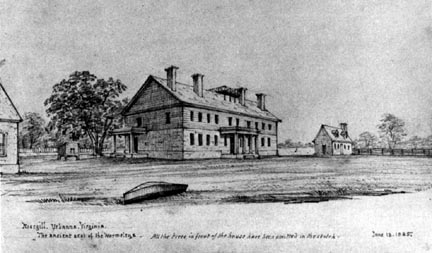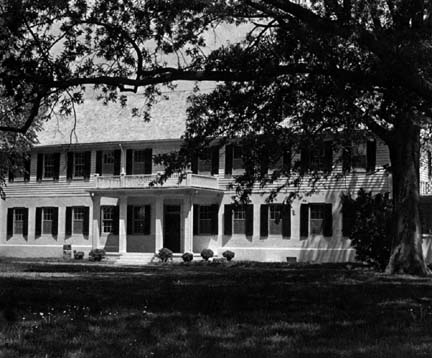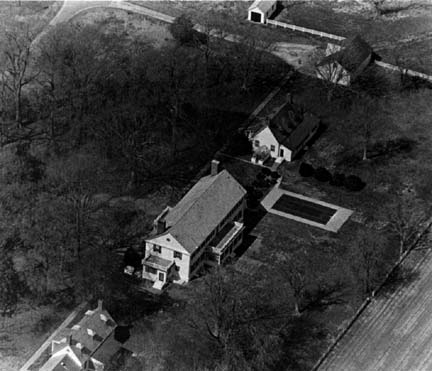| Rosegill |
|
From "Historic Buildings in Middlesex County, Virginia, 1650-1775" by Louise E. Gray, Evelyn Q. Ryland and Bettie J. Simmons. Library of Congress Catalog #78-70387 Published as part of the Bicentennial Celebrations under the sponsorship of the Middlesex County Board of Supervisors and under the direction of the Middlesex County Bicentennial Book Committee. |

Courtesy of Elizabeth Gookin, From the Sketchbook
of George Monier Williams
|
"Acquisition of large tracts of land was a quick and sure way to affluence in the colonial establishment," and for the Wormeleys of Rosegill a sure way to influence in the colony. Rosegill was to be the home of five generations of Wormeleys, all important in the hierarchy of the colony. The history of Rosegill, like that of all important great houses, was significant in the colony's beginnings, for its contributions to leadership in government, and in the life of church and parish. Early in its history it became a center of influence and power in the commercial life and shipping on the Rappahannock. Significant too was its connection with every great house in the colony, especially those in Middlesex. In 1649 Ralph Wormeley patented 3,200 acres on Rosegill Creek and the Rappahannock River, ten miles up the river from the bay, which land included the Indian Towns of Old and New Nimcock. Later Rosegill Creek was to be called Nimcock and then Urbanna Creek. Ralph Wormeley's plantation on the York River across Wormeley's Creek from the Moore House was owned by Capt. Ralph Wormeley, Esq., of his Majesty's Councill and by his descendants, the Wormeleys of Rosegill, until 1766. When Ralph Wormeley died in 1651 he left two infant children and his widow, Agatha Eltonhead Wormeley. A short time later she married Sir Henry Chicheley, who in 1650 had been a guest in the Wormeley home in Virginia, "but before the said marriage was compleate, Agatha Wormeley by an instrument in wrighting under her hand Seale Settled the Estate of Ralph Wormeley (considerable estate in Houses, Land, Plats, Jewels, Goods, Household Stuff, Horses, Mares, Tobacco, Negroes, English Servants and other estates within the Counties of Yorke and Lancaster now the said County of Middlesex in Virginia)."1 Rosegill must have been established between 1650-1654, for in that year Sir Henry at Rosegill was paying taxes on 24 titheables, the largest number by far of any plantation on the Rappahannock. By 1666 the Christ Church Vestry Book spoke of Rosegill as the house of Sir Henry Chicheley and of Lady Chicheley's land,2 and Rosegill was to be his home for thirty years. It was he who first brought to Rosegill the distinction of being the home of a governor of Colonial Virginia. He served as a member of the Council until his death, and while its president he was acting Governor during two separate periods. His heir and stepson, Ralph Wormeley II, like his father before him served as Justice, Burgess, and member of the Governor's Councill. He was a member of the Christ Church Vestry, was Collector of His Majesty's Customs, Naval Officer in the Rappahannock, and one of the first trustees of William and Mary College. He was recognized by his contemporaries as one of the most powerful men in Virginia. The town of Urbanna, its original fifty acres in 1680 being part of Rosegill, was founded and grew under the watchful eye and protection of Rosegill. Ralph Wormeley II married the widow of Col. Peter Jennings, Attorney General of Virginia, and the daughter and heiress of Sir Thomas Lunsford. After her death he married Elizabeth Armistead of Hesse in Gloucester County, and she later married Col. William Churchill of Bushy Park, grandfather of the Churchill developer of Wilton. Rosegill must have been an elaborate complex in the lifetime of this Ralph Wormeley. In 1686 a French Huguenot immigrant, M. Duval, described it "at least twenty houses along the plateau above the river." That the library was one of the finest in all Virginia is evident from the estate inventory. Indicative too of its splendor in this period was its serving for two years as the residence of another Colonial Governor, Lord Howard of Effingham. Of all the homes offered to him, he chose "the best of Ralph Wormeley's houses at Rosegill." Ralph Wormeley III, son of Ralph Wormeley II, died young but not before serving as Sheriff, Collector of Customs, and Vestryman at Christ Church. His successor as master of Rosegill was his nephew, Ralph Wormeley IV, who married Sarah Berkeley of Barr' Elms. It is thought that they built the present Rosegill, for 1730-1750 has been established as its period of construction. Originally the house was one and a half story brick approximately 37 x 21 feet, covered by a gable roof with four interior brick chimneys. Mutual Assurance records and an insurance policy of 1801 in the Virginia State Library describe the house to have been a brick dwelling 87 feet long by 40 feet wide with a Dutch roof and with two brick wings 33 x 22 feet one story high, a brick kitchen 20 x 40 feet one story high, and a wash house balancing it, each connected to the main house by a covered way 86 x 9 feet. The same records indicate nine other buildings as part of the complex. |

|
The facade of the present building with its eleven bays was probably so enlarged in the mid 1700s. The twelve foot wide hall across the entire river front with stairways at either end was also probably of the same period. The sienna marble mantel that still graces the handsome drawing room is similar to one at Carter's Grove ordered in 1771. This room with its eight-panel doors and paneled walls appears unchanged today. This was the Rosegill Ralph Wormeley V left when he died an old man in 1806. Letters he wrote shortly before his death complain of lack of money to pay his expenses and ferriages for a Williamsburg meeting and expressed fear that the churches reverting to all the Sectaries would engage in bitter dispute and contentions "polluting the mild and humble religion of Jesus." He, as his family before him, maintained "his aristocratic feelings and general pro-British stance." Early in the War this stance caused his exile into Berkeley County and while banished, his Rosegill was plundered by Tory privateersmen. The American Revolution had destroyed the King's Councillors as a separate entity of Virginia society, and although Wormeley settled into the new regime and was elected to the Virginia Convention of 1788 and the House of Delegates, he never changed his beliefs. Perhaps the last of the old colonial order, Ralph Wormeley was succeeded by no male heir to inherit Rosegill or to inherit the Colonial tradition of family, financial or political. His will in 1805 left tobacco to Mr. Reeves of London, the Reeves Bible to daughter Beverly, Encyclopedia to Mann Page, and to his wife Eleanor, Rosegill for life-Rosegill, the Pine Quarter, Hog House and Black Walnut.3 Martha Roy inherited 3,322 acres of Rosegill from her sister Mrs. Wormeley,4 and Thomas Boswell Roy received it in 1834 from his mother.5 In 1849 Capt. John Bailey of Lancaster County purchased Rosegill from Roy, and it was under the Captain's direction that Rosegill acquired its present face. Capt. Bailey was an orphan, and Col. John Chowning, a cousin of Capt. Bailey's mother, was his guardian. Bailey early was a seafaring master and accumulated a large fortune before retiring to Rosegill. Dr. Robert Christian wrote of his friend, "Brave, generous, and free, Capt. Bailey walked the lawn and observatory of his residence with his glass as if he were on the quarter deck of his ship, noting the movements of the hands in the fields and every vessel and boat that sailed the Rappahannock. With a lavish hand he made his home furnish every comfort that his family or friends could desire." Capt. Bailey raised the main body of the house to two full stories with a gable roof, facing the second story with weather boards and stuccoing and scoring all brick walls. Greek Revival trim replaced earlier exterior trim, porticos were replaced, but interior paneling was retained. One early exterior feature that still remains is the beveled water table. |

|
Capt. Bailey's will left Rosegill to his wife Eliza Bailey for life and then to grandnieces, Mary E. and Fannie B. Glidden of New Orleans.6 In 1901 Mary E. Glidden Temple was sole owner and sold Rosegill to J. Henry Cochran, United States Senator from Pennsylvania. Successive owners in the next forty years were Jessie K. and Norwood Smith, the Henry L. Bogerts of New York, and Ben Temple. In 1944 Sidney L. Shannon and his wife Katherine of Fredericksburg bought Rosegill, and it was their home until his death in 1970. Mrs. Shannon continued to live there until 1975 when she sold to Alfred P. and R. Strother Scott, the present owners. The mansion is currently a residence of the president of Colonial Williamsburg, Inc., Charles Longsworth and Mrs. Longsworth. Rosegill underwent major remodeling in the early 1940s. Paneling in the East Room was moved to the West Room, and the one story rooms at either end of the house and a one story sun porch on the river front were added. The smokehouse remains, and the kitchen retains its original eight foot wide fireplace opening. A brick on the east wall of the carriage house is inscribed "RW". The affection and pride that Middlesex County holds for the plantation of Colonial governors and the respect and appreciation of this county for the contribution of Rosegill's builders and preservers were dramatically exemplified in 1977 when fire threatened devastation of the great house. The entire community rallied to save its mansion, a rich significant relic of Colonial Virginia. |
|
1. Will Book 1673-1680, p. 103 |
6.
Will Book 8, p. 497 Other References: Ewing. Unpublished paper on Rosegill by Joseph Ewing, Jr.'s father Carroll C. Chowning Papers at Virginia Historical Society |
Will
Book B, p. 10 Will Book G, p. 191 Will Book E, p. 113 Will Book A, p. 84 |
|
|